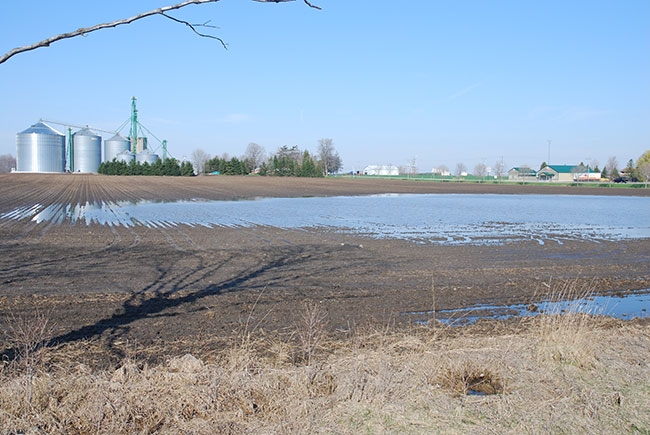
Features
Agronomy
Protecting the farm against extreme weather
Keith Currie, president of the Ontario Federation of Agriculture, says while the agricultural sector has a long history of learning and adapting to the variability of Canada’s weather and climate, global warming and climate change present a much more formidable challenge to agricultural production because of more frequent extreme weather events and changes to regional water cycles.
April 16, 2018 By Trudy Kelly Forsythe
 Keith Currie
Keith Currie“The uncertainty and variability resulting from climate change presents significant increased risk to food production and rural livelihoods,” Currie says.
To protect their livelihoods, farmers can access a number of programs that offer coverage in the case of extreme weather. In Ontario, Agricorp delivers a variety of programs and payments on behalf of the federal and provincial governments to help protect Ontario producers against many of the business and agricultural risks they face every day.
“Right now happens to be renewal and enrolment time for most business risk management programs,” says Stephanie Charest, AgriCorp’s customer communications manager. “Having the right risk management coverage to meet the unique needs of a farm is important, and application and renewal season is a good time for producers to make sure their coverage is a good match to what their farms look like today.”
“As a farm evolves and the industry changes, so can coverage needs,” Charest says, explaining that the federal and provincial governments provide a comprehensive suite of business risk management programs to help mitigate risks. “Producers can maximize their coverage by enrolling in these programs.”
It is important to note that different programs cover different risks.
Production insurance
Production insurance guarantees producers a level of production in case they experience challenges beyond their control, such as hail, excessive rainfall and drought. Plans are available for more than 100 commodities based on yield, dollar value or acreage loss with producers receiving a payment when an insured peril, such as hail, excessive rainfall and drought, causes their yield to fall below their guaranteed production.
“Final production losses are known after harvest when we have the full picture of crop results,” Charest says. “Generally, our customers report their final harvested yields from late November to early December. Producers also report crop damage as soon as it occurs.”
Most production insurance plans offer the following types of claim payments:
- Reseeding claims cover the costs of replanting some or all of a crop that experiences damage because of an insured peril, such as hail, excess rainfall or drought
- The unseeded acreage benefit helps offset the financial burden when a farmer is unable to plant a crop due to an insured peril, except drought
- Production claims are determined at the end of the growing season (late fall) when actual yield is known.
There is also a forage rainfall plan with excess rainfall and insufficient rainfall options. It uses measured rainfall as an indicator of forage quality.
Application and renewal time for most production insurance plans is May 1, 2018.
Wildfires
Wildfires are not an insured natural weather peril so they are not eligible for production insurance, which covers weather risks that are beyond a producer’s control, such as drought, hail and wind. That said, there are options to buy private insurance coverage for fire due to third party liability, such as machinery breakdown, which is typically more common. If this occurs, Agricorp would make sure any crop losses do not affect their yield averages that are used for future coverage.
Producers who experience production losses due to wildfires can access coverage through business risk management programs with AgriStability, protecting the farm income as a whole; AgriInvest helping producers recover from small income shortfalls; and Ontario’s SDRM: Edible Horticulture, helping producers mitigate general risks associated with their farm business.
AgriStability
AgriStability helps protect against risks like unexpected, large declines in income. It protects the farm income as a whole instead of one commodity at a time.
“AgriStability is an affordable option and producers can get coverage for a low fee of $315 for every $100,000 of their reference margin,” says Charest. “Producers receive a payment if their farming income falls below 70 per cent of their farm’s recent average income.”
April 30 is the last day to apply and renew for the 2018 tax year. Producers submit claim forms by June 30, 2019 to determine if they qualify for a payment.
Risk Management Program
The risk management program (RMP) helps producers offset losses caused by low commodity prices and rising production costs. RMP is available for grains and oilseeds, as well as cattle, hogs, sheep and veal. Producers receive payments if the market prices fall below their chosen support level. There are three payment periods for RMP for livestock and two for RMP for grains and oilseeds.
The application and renewal dates are April 1 for RMP for livestock and May 1 for RMP for grains and oilseeds.
SDRM: Edible Horticulture
SDRM: Edible Horticulture is part of RMP and helps edible horticulture producers mitigate general risks associated with their farm business. Producers receive a government contribution based on their annual deposit into an SDRM account. Their maximum deposit is a percentage of their allowable net sales and is set in September.
A withdrawal request can be submitted at any time after a deposit has been made.
AgriInvest
AgriInvest helps producers recover from small income shortfalls or make investments to reduce their farm’s risk. Producers receive a matching government contribution based on their annual deposits into an AgriInvest account. Their deposit is a percentage of their allowable net sales.
The application and renewal date for AgriInvest is Sept. 30, 2018.
There is also an AgriRecovery Framework, which may respond when natural disasters occur.